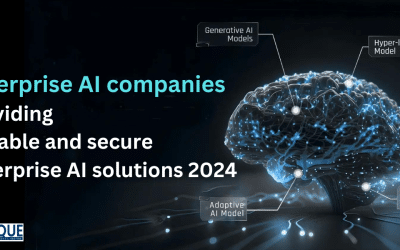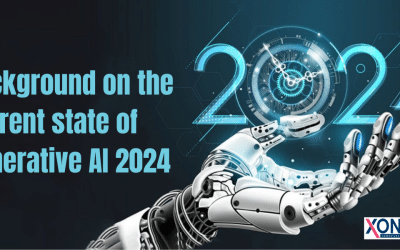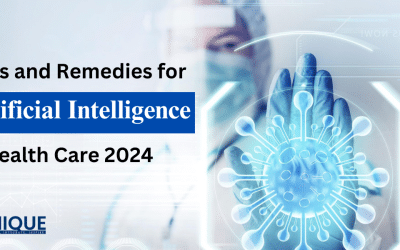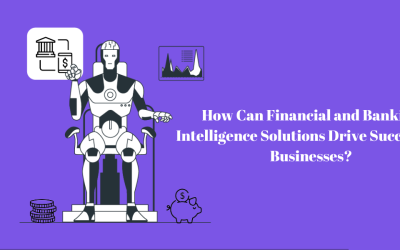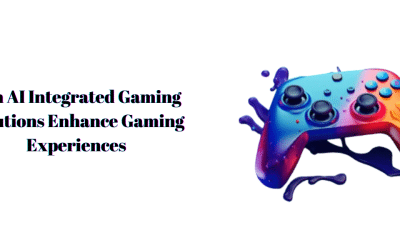Thanks to advances in artificial intelligence, the field of manufacturing enterprises’ AI solutions will continue to change in 2024. As businesses adopt digital transformation at a phenomenal speed, the advancement of AI technologies is expected to be a huge opportunity to increase efficiency, improve processes, and encourage the development of new ideas.
Making solid AI solutions specifically designed for manufacturing companies starts by thoroughly grasping specific industry challenges and opportunities. In addition to predictive maintenance, quality controls, and optimizing supply chains and automated processes, AI offers multifaceted applications that can transform traditional manufacturing processes. These techniques use massive amounts of data from IoT equipment, sensors, and production systems. They enable instantaneous insights and proactive making.
Machine learning algorithms, deep learning models, and natural techniques for processing languages are critical components of developing efficient AI solutions. These tools enable manufacturers to study large data sets, identify patterns, and accurately predict outcomes. Additionally, AI-driven automation improves workflows, minimizes human error, and speeds up time to market, thus increasing overall efficiency and competitiveness.
A successful adoption for the successful implementation of AI software development within manufacturing calls for a comprehensive approach that includes data collection, processing models, training and deployment, and continual optimization. Collaboration between data scientists, domain experts, and IT experts is vital to ensure that the AI initiatives meet the business goals and operational needs.
Steps to Build Enterprise AI Solutions for Manufacturing in 2024
AI promises improved efficiency, quality, predictive maintenance, and cost savings. However, creating robust AI solutions for manufacturing requires a systematic approach combining technical expertise, domain knowledge, and meticulous planning. These are the key steps to implement AI solutions within manufacturing firms this year:
Define Clear Objectives and Use Cases
Before launching the AI project, it’s essential to set clear objectives that align with the business objectives. Determine specific areas in manufacturing processes where AI could have a tangible impact. This could be as simple as predictive maintenance to decrease the time between maintenance, quality control to reduce errors, demand forecasting to improve inventory management, or supply chain optimization to improve efficiency.
Data Collection and Preparation
AI models are just as effective as the data they’re taught on. Manufacturing companies must invest in reliable data collection systems to gather relevant data from multiple sources, such as sensors, IoT equipment, ERP software, and historical records. Data quality is crucial, so thorough cleaning, normalization, and augmentation processes are required to ensure reliability and accuracy.
Infrastructure and Platform Selection
Selecting the appropriate technology and AI platform is essential for successfully implementing AI applications in manufacturing. When choosing an option for your software solution, consider aspects such as security, scaling, integration into existing systems, and compliance requirements. Cloud-based solutions can be flexible and capacity-based, while on-premises solutions give greater control over data and compliance.
AI Model Development and Training
Making AI models specifically designed for manufacturing requires expertise in deep learning, machine learning, and domain knowledge. Work with data scientists, domain experts, and AI engineers to create models tailored to specific situations. Use historical data for training and validation, ensuring the models can adapt effectively to actual-world situations.
Testing and Validation
Thorough validation and testing are vital to ensuring the accuracy and effectiveness of AI solutions for manufacturing. Conduct rigorous tests under various circumstances to simulate real-world situations and edge scenarios. Review the performance indicator against industry standards and benchmarks and the most critical performance Indicators (KPIs) to ensure that your AI solution successfully achieves the desired outcomes.
Integration with Existing Systems
Integrating AI solutions into existing manufacturing processes is crucial to ensure seamless implementation and operation. Integrate and ensure compatibility between ERP, MES (Manufacturing Execution Systems), SCADA (Supervisory Control and Data Acquisition), and IT platforms. Middleware and API-based integrations will facilitate seamless data flow and communications among AI algorithms and the operational system.
Deployment and Monitoring
Implement AI strategies gradually to ensure no disruption to your operations. Create complete analytics and monitoring dashboards that track performance metrics, spot irregularities, and continually improve AI models. Set up a system for regular updates, retraining, and maintenance to adjust to changing business requirements and environmental conditions.
Security and Ethical Considerations
Prioritize privacy and data security throughout the AI cycle, from data collection to storage to models’ deployment and use. Implement encryption, access control, and adherence to industry regulations (such as GDPR or CCPA) to protect sensitive data. Consider ethical issues like bias mitigation in AI algorithmic processes to guarantee fair and equal results.
Continuous Improvement and Optimization
AI in manufacturing isn’t only a once-off implementation but an ongoing process of advancement. Make a culture of collaboration and innovation across teams to find new applications and opportunities for AI deployment. Use feedback loops derived from the inputs of users and operational data to boost the precision and accuracy of Artificial Intelligence models and increase the precision of predictions made by AI models.
Knowledge Transfer and Skill Development
Insist on educating employees to make the most of the potential of AI technology in manufacturing. Training programs are provided on AI basics, including data literacy and AI modeling, to help empower teams from different roles. Facilitate cross-functional collaboration among engineers, data scientists, and domain experts to encourage creativity and accelerate AI adoption.
Goals and Objectives for AI Integration
AI development companies play an integral role in this transformational process and offer AI solutions to tackle complex problems and open up new opportunities. This article examines the fundamental purposes and objectives of AI integration, focusing on the role and contribution of AI development firms.
Enhancing Operational Efficiency
One of the primary objectives of AI integration is to increase operational efficiency. AI development firms develop sophisticated technology and programs that automate repetitive and routine tasks, reducing the need for human involvement. For example, in manufacturing AI-powered machines, robots can complete tasks with high precision and speed, resulting in higher productivity and lower errors. Like customer service, AI chatbots can handle many requests by providing fast and accurate answers without human intervention.
The aim is to reduce costs and free up resources for more innovative and strategic tasks. By automating routine tasks, businesses can shift their employees to areas that demand critical thinking, problem-solving, and creativity. This could lead to substantial improvements in the organization’s overall performance.
Enhancing Decision-Making
AI integration seeks to improve decision-making by delivering data-driven insight and predictive analysis. AI development firms specialize in developing sophisticated tools for data analysis that analyze large quantities of data, find patterns, and then provide insight. In the financial industry, AI algorithms can predict market trends, evaluate risk, and suggest investment strategies. AI can analyze patient data in healthcare to anticipate illness outbreaks, optimize treatment plans, and improve patient outcomes.
The goal is to allow businesses to make educated decisions quickly and efficiently. By using AI-driven insights, companies can respond more efficiently to changes in market conditions, customer preferences, and new opportunities. This is essential in today’s highly competitive and fast-paced business environment.
Personalizing Customer Experiences
Another primary purpose of AI integration is to customize the customer experience. AI development companies create sophisticated algorithms that examine customer behavior, preferences, and feedback to design individualized interactions. In the retail sector, for example, Artificial Intelligence can recommend products according to a consumer’s purchasing history and browsing habits. In the entertainment sector, AI can suggest movies or music based on the customer’s previous preferences.
The target is to increase customer satisfaction and loyalty by tailoring experiences to individual preferences and needs. Personalized experiences result in greater customer engagement, better conversion rates, and longer-term customer retention. By anticipating and recognizing customers’ needs, businesses can create stronger relationships and accelerate their growth.
Innovating Products and Services
AI integration also can lead to innovations in products and services. AI firms that create goods and services have been at the forefront of developing new technology to revolutionize various sectors. In the automotive industry, AI enables the creation of autonomous vehicles that can move and make decisions without human involvement. Diagnostic tools powered by AI will quickly review medical photographs and diagnose diseases. In the health industry, diagnostic tools powered by AI can quickly analyze medical images and identify ailments.
The goal is to develop new, exciting solutions and products that satisfy unmet needs and resolve complicated issues. Through the integration of AI, companies can differentiate their offerings from those of competitors and develop distinctive value propositions. AI-driven innovation AI could open new markets and revenue streams and position companies to be successful over the long term.
Improving Security and Compliance
Compliance and security are crucial for many businesses, and AI integration is designed to tackle these issues. AI development companies develop sophisticated security systems that detect and react to threats in real time. For instance, AI can monitor network traffic, spot suspicious activity, and issue alarms to protect against cyberattacks. In finance, AI can analyze transactions to spot fraud and ensure that the transaction complies with regulations.
The aim is to improve businesses’ overall security and conformity capabilities using AI’s capabilities for threat detection, risk assessment, and regulatory compliance. By integrating AI into security solutions, organizations can safeguard sensitive information, ensure regulatory compliance, and decrease the chance of financial losses and reputational harm.
Promoting Sustainability
AI integration can also encourage sustainability and tackle environmental issues. AI businesses are developing solutions to improve resource efficiency, decrease pollution, and limit environmental impacts. AI can optimize energy consumption in the energy industry by anticipating demand and altering supply accordingly. In the agricultural sector, AI can monitor crop health, improve irrigation, and reduce the application of pesticides and fertilizers.
The goal is to use AI to implement sustainable practices that reduce business’s environmental impact and help create a more sustainable future. By integrating AI, companies can meet sustainable goals, adhere to environmental regulations, and boost their social responsibility programs. Using sustainable practices facilitated by AI could also bring about efficiency and cost reductions.
Facilitating Collaboration and Communication
AI integration is designed to improve collaboration and communication within companies. AI development companies design platforms and tools that allow effortless communication and cooperation among team members regardless of their location. For instance, AI-powered collaboration tools allow scheduling meetings, translating conversations, and offering language translations in real time.
The aim is to increase collaboration and efficiency by removing communication barriers and enabling effective collaboration. With the help of Artificial Intelligence Industries can construct a more flexible and productive workforce, able to adapt to challenges and opportunities rapidly and effectively. Better collaboration could improve decision-making, faster project completion, and greater employee satisfaction.
Supporting Workforce Development
AI integration is also designed to assist in developing workforces by providing opportunities for training and development. AI development companies are developing platforms that provide customized learning experiences and development programs. For instance, AI can recommend training modules based on an employee’s skills and future objectives. Additionally, AI-powered virtual coaches can provide instant feedback and advice to employees.
The aim is to provide employees with the capabilities and expertise required to be successful in an environment that is dominated by AI. Organizations can build an environment encouraging continuous learning and development by including AI in workforce development programs. This can result in greater employee engagement, better productivity, and an agile and flexible workforce.
Types of AI Models Used in Developing Enterprise AI Solutions for Manufacturing
This article highlights the advantages and applications of the different AI models in developing enterprise AI tools for the manufacturing industry.
Machine Learning Models
Machine-learning models comprise the bulk of popular production tools that are powered by machine learning. These models are trained from data collected to help make predictions and optimize processes. Many types of models use machine learning, including:
Supervised Learning
Supervised learning is the process of training models using labeled data where the input-output pairings are well-known. In manufacturing, supervised learning models can help predict machine failures, classify product defects, and improve production schedules.
- Predictive maintenance analyzes sensors from machines, which are supervised learning models. It can determine the likelihood of a machine failing. This allows companies to conduct maintenance proactively, reducing repair time and prolonging the equipment’s life.
- Quality Control: The models can categorize products based on quality by looking at photos or sensor data. For instance, they could detect defects in products in an assembly line, ensuring that only the best products are sold on the market.
Unsupervised Learning
Unsupervised learning models identify patterns in data that are not labeled with results. They help cluster similar items, detect anomalies, and determine the data’s fundamental structures.
- Anomaly detection Unsupervised learning models can detect abnormalities in manufacturing processes by finding deviations from standard patterns. This is vital for spotting problems such as equipment malfunctions or inefficiencies.
- Demand forecasting involves analyzing sales records from the past. These models can spot patterns and trends and predict future demand. This allows manufacturers to plan their production more precisely and effectively manage inventory levels.
Reinforcement Learning
The process of reinforcement learning consists of creating models by experimentation by using a system of reward as well as penalties. This kind of model can be particularly beneficial for improving complicated manufacturing processes.
- RPA: Robotic Process Automation (RPA): Reinforcement learning teaches robots to do tasks efficiently. For example, robots can discover the best route to build or move factory products.
- Supply Chain Optimization These models can optimize supply chain operations by discovering the most effective methods for managing logistics, inventory, and distribution.
Deep Learning Models
Deep learning, which is one of the subsets of machine-learning, involves the use of neural networks that have multiple layers for analyzing intricate patterns of information. Deep learning algorithms are incredibly efficient for tasks requiring vast amounts of unstructured data, such as audio, images, or text.
Convolutional Neural Networks (CNNs)
CNNs are unique deep-learning models that process grid-like information, such as images. CNNs are widely used for visual inspections and quality control in the manufacturing industry.
- Visual Inspection: CNNs can analyze images of products to identify imperfections and ensure they meet high-quality standards. This is especially useful in areas such as automotive electronics manufacturing, where precision is crucial.
- Predictive Maintenance: Through the analysis of machine photographs, CNNs will be able to identify the early indications of wear and tear permitting timely maintenance as well as preventing sudden malfunctions.
Recurrent Neural Networks (RNNs)
RNNs are deep-learning algorithms specifically designed for data that is sequential like natural language, or time series. They can be used in the manufacturing industry for predictive maintenance and demand forecasting.
- Time-series forecasting RNNs can analyze historical data to predict the future direction of sales, production, and equipment performance. This can help manufacturers improve their processes and anticipate future demands.
- Predictive maintenance RNNs can analyze the data of machine sensors to determine when maintenance is required. This can reduce downtime and increase the equipment’s lifespan.
Natural Language Processing (NLP) Models
NLP models allow machines to comprehend and interpret human languages. In manufacturing, NLP can perform tasks like document analysis, client service, or voice-controlled interfaces.
Text Analysis
NLP models can analyze text data to gain insights and automate various tasks.
- Document Analysis: NLP can analyze technical documents such as manuals, reports, and guides to discover pertinent information and reveal trends. This assists manufacturers in staying up to date with industry guidelines and best practices.
- Customer support Chatbots powered by NLP can answer customer questions, offer troubleshooting assistance, and provide product information. This increases customer satisfaction and eases the load on human staff.
Voice Recognition
Voice recognition technology allows the hands-free operation of equipment and machinery, improving manufacturing environments’ safety and efficiency.
- Voice-controlled interfaces: Users can use devices and get information via voice commands, eliminating the physical need to interact with equipment. This is especially beneficial when hand-free operation is required to ensure safety.
Computer Vision Models
Computer vision is the application of AI to comprehend and interpret visual information from all over the world. In the manufacturing industry, computer vision models control quality, monitor processes, and automate.
Image Recognition
Image recognition software can recognize patterns, objects, and imperfections in images.
- Quality Control The models can check the products in the production line to identify imperfections and ensure they meet quality standards. This helps reduce the requirement to perform manual inspections and improves productivity.
- Process monitoring Computer vision can observe manufacturing processes in real-time and identify any issues or deviations that could be present. This allows for the quality of the product and improves production.
Object Detection
Object detection models can identify and locate objects in an image.
- Robotics: Object detection is vital for robots that detect or manipulate things. For instance, a robotic arm in an assembly line could utilize object detection to identify and put components in the correct order.
- Security Monitoring The models inspect factory floors for possible safety risks, such as misplaced items or unauthorized personnel. This improves safety at work and decreases the chance of accidents.
Optimization Models
Optimization models employ mathematical algorithms to determine the most effective solutions to complicated issues. In manufacturing, these models are used for planning production, supply chain management, and resource allocation.
Linear Programming
Linear programming models enhance the production process by solving linear equations subject to constraints.
- Production Scheduling The models can optimize production schedules to increase efficiency and reduce expenses. They consider factors like the availability of labor, machines, and constraints on materials.
- Supply Chain Management Linear programming can improve supply chain operations by efficiently using resources, including transportation routes and inventory levels.
Genetic Algorithms
Genetic algorithms are optimization models built on the concepts of genetics and natural selection. They are employed to find the most effective solutions to complex problems involving many variables.
- Process Optimization Genetic algorithms can optimize manufacturing processes by investigating myriad solutions. This can increase product quality while reducing waste and improving efficiency.
- Design Optimization The models improve product designs by analyzing various design parameters before deciding on the most appropriate combination. This enables manufacturers to design highly efficient and high-performance products.
The benefit of using AI for companies manufacturing by 2024
Incorporating AI software solutions can provide many advantages, changing conventional manufacturing techniques into cost-effective, more effective, and efficient systems. Here are the top benefits of implementing AI for manufacturing companies by 2024.
Enhanced Production Efficiency
One of the most significant advantages of AI development in manufacturing is the improvement of productivity. AI systems can help optimize production lines by anticipating maintenance requirements, which reduces time to repair and streamline processes. Predictive maintenance, aided by AI, can allow manufacturers to detect the possibility of equipment failures before their occurrence, reduce the number of interruptions in production, and ensure a constant production flow. Machine learning algorithms analyse the data gathered by various sensors that are placed on the production floor to identify patterns and irregularities. This assists in scheduling maintenance tasks when they are most appropriate.
Quality Control and Assurance
The use of AI in quality assurance systems has revolutionized methods so that manufacturers can ensure the quality of their products. Traditional methods for quality control typically depend on manual inspections, which are time-consuming and vulnerable to errors. On the contrary, AI employs modern image recognition technology and machine-learning methods to check products in real time and identify imperfections with greater precision and speed. This ensures that only items of the highest quality can be put on the market, decreasing the amount of waste and increasing customer satisfaction.
Supply Chain Optimization
The use of AI in manufacturing is a significant factor. AI in manufacturing extends far beyond the floor of production. AI developments in manufacturing substantially impact the management of supply chains. AI algorithms can accurately forecast demand, improve inventory levels, and enhance logistics. By studying the past, market trends, and external influences, AI can predict future demand accurately. This helps manufacturers maintain optimal inventory levels, thus reducing the chance of stocking up or stock-outs. In addition, AI can optimize logistics by determining optimal routes and methods, reducing cost, and enhancing delivery time.
Cost Reduction
AI implementation results in significant cost savings in manufacturing firms. Automating repetitive tasks can reduce manual labor requirements and labor costs. In addition, predictive maintenance can reduce the expenses related to equipment breakdowns and repairs. AI can also improve energy efficiency by adjusting the operation of machinery according to real-time information, which results in significant energy savings. Additionally, better quality control can reduce the expense of rework and waste, contributing to the overall efficiency of costs.
Enhanced Product Development
AI advancement in manufacturing allows for speedier and more efficient development processes. AI-powered design tools can produce multiple design variations based on specific criteria, allowing engineers to investigate various designs quickly. The tools employ machine learning algorithms to study previous designs and find patterns that can lead to the most successful products. Additionally, AI can simulate product performance under various conditions, which allows manufacturers to improve their designs before moving on to the prototyping phase. This speeds up the development process and decreases the time to market for new product launches.
Improved Worker Safety
AI technologies can improve worker safety in factories. Robots powered by AI and cobots (collaborative robots) can handle hazardous routine tasks, which reduces the possibility of workplace injuries. In addition, AI systems can monitor the working environment in real-time by identifying dangers and alerting employees and supervisors in case of accidents. Wearable AI devices can monitor workers’ health-related metrics like fatigue and heart rate, warning early about circumstances that could cause accidents. An active approach to ensuring that safety is to ensure the health and safety of the workers and their families in an atmosphere that is conducive to employees.
Customization and Flexibility
In 2024, demand from consumers for personalized products will be higher than ever. AI lets manufacturers offer more customization and flexibility in their manufacturing processes. AI-powered systems can quickly analyze consumer preferences and market trends to design and create customized products. Systems for manufacturing that are flexible and powered by AI can change between various product lines without much downtime, which allows manufacturers to respond swiftly to the changing demands of customers. This is not just a way to increase the satisfaction of customers but also provides an edge in the marketplace.
Sustainability and Environmental Impact
Sustainability is now a significant aspect of manufacturing companies. AI advancements in manufacturing encourage sustainable practices by maximizing the use of resources and decreasing the amount of waste. AI algorithms can analyze patterns in energy consumption and pinpoint opportunities to save energy. In addition, AI-powered systems could improve the use of materials, thereby decreasing the amount of raw materials that are used for production. In reducing waste and improving efficiency in resource use, AI helps manufacturers reduce their carbon footprint while achieving sustainable goals.
Data-Driven Decision Making
The sheer volume of data produced by manufacturing processes can be overwhelming to handle and analyze manually. AI technology in manufacturing allows data-driven decision-making through processing and analyzing massive datasets quickly and efficiently. AI systems can offer insights into manufacturing performance and efficiency of supply chains, along with market and industry trends, enabling manufacturers to make educated decisions with real-time information. This method of data-driven decision-making helps improve strategic planning, increases efficiency in operations, and spurs innovations.
Competitive Advantage
Implementing AI in manufacturing companies can give them a competitive advantage. First companies that adopt AI technology could gain from AI’s advantages and compete with rivals on efficacy, product quality as well as customer satisfaction. AI-driven innovation enables manufacturers to launch new products and services more quickly by gaining market share while staying ahead of industry trends. Furthermore, AI enables manufacturers to adapt to market shifts quicker, ensuring the longevity of competitiveness in an ever-changing business environment.
Workforce Empowerment
There is a general belief that AI can take over human work, but it is better to claim that AI could enhance and improve the work force. AI may take over repetitive and boring tasks, allowing workers to concentrate on more complex and innovative aspects of their jobs. This can not only increase satisfaction at work but also increase productivity. In addition, AI-powered programs for training allow workers to develop new capabilities and adapt to new demands on their jobs, creating that they are skilled and able to adapt.
Enhanced Customer Experience
AI advancements within manufacturing directly affect the customer by improving the overall experience. More efficient production processes, higher product quality, and more possibilities for customization result in superior products that more efficiently satisfy customer demand. AI can also aid in improving customer service by providing immediate information regarding the state of order, as well as individualized suggestions based on the customer preferences. This kind of service can help build better customer relations and loyalty.
Innovation and Future-Readiness
AI promotes a culture of creativity within manufacturing firms. By automating repetitive tasks and providing insight through data analysis, AI frees up resources for research and development. Manufacturers can test new designs, materials, and methods, which drives constant advancement and new ideas. Additionally, AI prepares manufacturers for future opportunities and challenges by allowing them to adjust to changing technologies and market requirements quickly.
Cost To Develop Enterprise AI Solutions for Manufacturing Businesses
The costs of developing enterprise AI solutions to support manufacturing companies will vary depending on various variables. This article examines the main elements of cost, the influences on these costs, and the possibility of an ROI (ROI) for manufacturing companies considering implementing AI solutions.
Research and Development (R&D) Costs
- Initial Study: The initial phase in creating AI solutions involves conducting a thorough study. This involves understanding the unique requirements of manufacturing businesses, analyzing the existing processes, and finding areas where AI will add value. The price for this process will vary based on the degree of difficulty involved with manufacturing processes and the company’s unique needs.
- Prototyping: Following the initial Study, an initial prototype of the AI technology is designed. It involves constructing a simple version of the program or device to evaluate its potential. The cost of prototyping can range between a couple hundred thousand dollars to hundreds of millions depending on the level of complexity involved in the process.
Hardware and Infrastructure Costs
Servers and Storage: AI solutions require solid hardware to process massive amounts of information. This means high-performance servers and enough storage capacity. The cost of the servers could range between tens of thousands of dollars to billions dependent on the scale of your business.
- Networking equipment: The most advanced network equipment is required to guarantee seamless data exchange and communications among different elements in the AI system. This includes routers, switches and various other devices that could be a couple of thousand dollars your total price.
Software Development Costs
- Custom Software Development: The process of designing custom AI software that meets the particular requirements of a manufacturing company is a significant cost factor. This requires hiring expert programmers and data scientists to develop algorithms and models to meet the specific needs of manufacturing. Custom software development costs could vary from $30,000 to a few million dollars, contingent on the scope and complexity of the undertaking.
- License Costs: In some instances, businesses can include third-party AI software or tools in their software. These require licensing fees that can vary depending on the software company and the number of customers.
Data Acquisition and Management Costs
- Data collection: AI systems rely on large amounts of data for their operation. Collecting this data is an expensive process that requires sensors, IoT gadgets, and various other tools. The price to collect data can vary between several thousand dollars and hundreds of thousands of dollars, depending on the amount of data needed.
- Data Storage and Administration: Storing and managing the information collected is yet another major expense. It includes creating databases, assuring the security of data, and setting up data management processes. Storage and administration may range between thousands and many thousands annually.
Integration and Implementation Costs
- Systems Integration: Integrating the AI solution into current processes and systems within the manufacturing industry is challenging. It involves modifying the software for your company’s workflows and making sure that it is seamless in communication with various platforms. System integration costs are usually between $10,000 and more than $100,000.
- Training and Assistance: When the AI solution is in place, employees must be taught how to utilize it efficiently. Training sessions are provided as user guides and ongoing support is provided. Costs for training and support could range between a few thousand and more than a hundred thousand dollars per year.
Factors Influencing the Cost
Complexity of the Solution
The more complicated the AI solution, the more expensive it is. Solutions that require complex algorithms, machine-learning models, and extensive data processing are more costly to create and deploy.
The Scale of the Operations
The magnitude of the manufacturing enterprise and the size of its operations will significantly affect the price. Businesses with more significant production will require more sophisticated and flexible AI strategies and become more expensive.
Customization Requirements
The price is also affected by the amount of customization needed to create the AI solution. Customized solutions designed to meet the company’s particular requirements will cost more than off-the-shelf options.
Data Requirements
The amount and the amount of data that is required to run the AI system will impact the expense. Incorporating, storing, and analyzing large amounts of data may be costly.
Vendor Selection
The vendor selection of software, hardware, and other elements of the AI solution can also affect the price. Different vendors provide various pricing models, and choosing the best supplier can optimize the cost.
Potential Return on Investment (ROI)
Although the initial costs for developing and implementing AI products for manufacturing firms could be costly, the ROI potential is enough to justify the investment. AI manufacturing firms could achieve substantial cost reductions and efficiency improvements through AI strategies.
Increased Efficiency
AI applications can improve manufacturing processes, reducing repair time and increasing effectiveness. This could lead to substantial cost savings and a rise in production capacity.
Improved Quality Control
AI will enhance quality controls by detecting anomalies and defects immediately. This will reduce the expense of rework, increase production quality, and lead to an increase in customer satisfaction.
Predictive Maintenance
AI-powered predictive maintenance will help detect potential equipment failures before they happen, reducing the time between breakdowns and maintenance costs. This will extend the equipment’s lifetime and increase the overall effectiveness of operations.
Supply Chain Optimization
AI helps improve supply chain operations by anticipating the demand for goods, managing inventory, and optimizing logistics. This will help reduce the costs related to overstocked inventory, stockouts, and inadequate logistics.
Enhanced Decision-Making
AI provides valuable insight and data analytics to support the use of data to make decisions. It can assist manufacturing companies in making more educated decisions that result in better results and profitability.
Things to Consider Before developing AI Solutions for Manufacturing
A successful deployment of AI applications requires a careful evaluation of various aspects. This article will discuss the essential elements companies must consider before beginning AI initiatives.
Data Availability and Quality
AI applications rely on the availability of data. Thus, one of the main elements to consider is the data’s quality and availability. Production environments produce vast amounts of information from many sources, such as sensors, machines, and enterprise systems. However, the data has to be organized, clean, and relevant to the issues being addressed. The steps to prepare the data for processing, including cleaning, normalization, and labeling, are vital to ensure that AI models learn efficiently from the information. In addition, historical data are typically required for training predictive models. Therefore, having complete and precise historical data will be helpful.
Integration into Existing Systems
In manufacturing, there are a lot of old equipment and systems. Integrating modern AI technologies with existing equipment can be challenging but is crucial for smooth operation. It is essential to determine whether or not it is compatible with AI applications and existing technology, tools, and workflows. It is common for this integration to require unique interfaces and middleware that assure smooth data exchange between AI software and existing infrastructure. It is possible to connect AI in conjunction with current ERP (ERP) software and manufacturing execution systems (MES), as well as other manufacturing control and automation systems, which are crucial to ensure that the operation is seamless.
Scalability and Flexibility
It is also a vital aspect to consider. AI applications should not just meet current requirements, but they should also be adaptable to any future expansion and changing requirements. This requires the creation of AI systems and models that can cope with increasing quantities and greater complexity over time. The same is true for flexibility, and AI software should be able to adapt to the changing manufacturing process, new product lines, and production requirements. This makes the AI solution effective and valuable over the long run.
Cost and ROI Analysis
Implementing AI methods in manufacturing requires an investment of significant magnitude, as well as financial resources and time. An in-depth cost-benefit analysis of the investment is crucial to calculate the rate of return on investment (ROI). The study must consider the initial setup cost, including hardware, software, integration, and ongoing operation costs, such as maintenance and updates. Potential benefits, including improved efficiency, less time to repair, and improved performance, need to be quantified to justify the expenditure. Understanding the financial consequences aids in making informed choices and securing stakeholders’ buy-in.
Workforce Readiness and Training
AI adoption in manufacturing affects the workers. AI implementation in manufacturing also impacts the workforce. AI could alter the roles of workers and demand new skills. Determining whether the workforce is ready to adjust to the changes is vital. It is necessary to develop training programs for employees to enhance their skills, enabling workers to use AI technology. It may include instruction on data analysis, machine-learning concepts, and how to operate AI-powered equipment. It is essential to ensure that your workforce is trained and engaged, which is vital in successfully adopting AI strategies.
Ethical and Legal Considerations
The use of AI in manufacturing has raised various ethical and legal questions that need to be addressed. Security concerns, specifically about the collection of data and its use, must be taken into consideration. Companies must ensure that they adhere to data protection regulations and industry norms. There are also ethical issues surrounding the displacement of jobs and the possible effects on workers. Communication with employees and other stakeholders regarding the advantages and ramifications associated with AI adoption is crucial for building trust and addressing any issues.
Technology and Vendor Selection
The selection of the appropriate technologies and suppliers is an important aspect. It is difficult to distinguish between AI services and technologies offering different features and options. It is crucial to assess the possibilities thoroughly, considering factors like technological sophistication, compatibility with existing technologies, and suppliers’ history. Test-of-concept and pilot studies will help you evaluate the efficacy of various AI options and vendors before deciding to implement a large-scale project.
Security and Reliability
Industries are frequently targets of cyberattacks. The introduction of AI adds security issues. Securing and ensuring the reliability of AI technology is crucial to safeguarding sensitive data and ensuring that operations continue. It is a matter of implementing strong security measures like access control, encryption, and regular security checks. Furthermore, AI systems should be constructed for reliability and high reliability using failover and redundant systems to avoid delays and interruptions.
Continuous Monitoring and Improvement
Manufacturing AI models require regular monitoring and improvements to stay productive. However, their efficiency may decrease over time due to changes in manufacturing procedures, machinery, or other external influences. Continuous monitoring and periodic maintenance are essential to ensure that AI systems continue producing exact and consistent outcomes. This involves establishing feedback loops, performance indicators, and mechanisms for continuous training and updates to the model.
Environmental and Sustainability Considerations
The importance of sustainability is growing for manufacturing companies. AI technologies can aid in more sustainable manufacturing processes by improving resource utilization, decreasing waste, and increasing energy efficiency. However, the creation and implementation of AI technology can cause negative environmental effects, such as power consumption associated with data processing and storage. You must consider these aspects and work towards eco-friendly AI options that align with larger ecological objectives.
Collaboration and Stakeholder Involvement
The success of AI manufacturing development requires the cooperation and involvement of diverse stakeholders, such as IT experts, engineers, management, and external suppliers. Cross-functional teams can offer a variety of viewpoints and knowledge, which can help in the development and deployment of AI solutions. Involving stakeholders in the entire procedure, from the initial deployment plan, ensures that AI solutions meet organizational goals and satisfy the demands of the various parties involved.
Conclusion
In 2024, the necessity for manufacturing companies to implement AI strategies is more significant than ever. Integrating AI into manufacturing processes is expected to bring more than incremental improvement; it will also bring disruptive changes that will alter operational efficiency, product quality, and even competitive advantage. Through the use of the power of AI in the enterprise, businesses can tap into vast amounts of data produced in the manufacturing process for actionable insight, optimize the production line, and anticipate maintenance requirements, thus reducing the time and expense of maintenance.
One critical aspect of using these strategies is knowing the specific challenges and requirements of the manufacturing industry. Custom-designed AI-based solutions for enterprises can tackle particular issues like managing the supply chain, inventory optimization, and energy efficiency. Furthermore, they allow seamless integration into existing systems, which ensures minimal disruption while maximizing the ROI.
The possibilities of AI for manufacturing are not limited to encouraging innovation. AI-driven analytics could lead to the creation of innovative material and product designs by analyzing the market and consumer preferences, thereby giving companies a competitive advantage. Additionally, using AI in manufacturing can increase workers’ efficiency and safety through high-tech robotics and automated quality control technology.
FAQs
What is the most significant benefit from the use of AI to manufacture companies in 2024?
Implementing AI in factories will bring benefits, including improved operational efficiency, decreased downtime, improved prescriptive maintenance, enhanced quality control, and improved managing supply chains. AI will also help automate repetitive tasks and allow human employees to concentrate on more challenging tasks.
Which AI technologies will be most useful in the manufacturing industry by 2024?
By 2024, the most effective AI techniques for manufacturing will include deep learning, machine learning, computer vision, artificial language processing (NLP), and edge computing. The technology is suitable for a variety of industries, like precise maintenance, quality control demand forecasting and automated robotic processes.
What is the best way to make AI help improve predictive maintenance within manufacturing?
AI enhances proactive maintenance by studying information from equipment and sensors to identify when machinery is most likely to break. This permits manufacturers to conduct maintenance only when needed, reducing downtime and the cost of maintenance. AI algorithms detect patterns and abnormalities that humans might overlook and guarantee that the outcomes are more precise and efficient actions.
What are the difficulties of integrating AI technologies into manufacturing companies?
Problems related to data quality and accessibility, the integration of the existing system, high investment costs, and the requirement for skilled people to design and manage AI solutions. Management and employees could also resist changes, as well as fear about data privacy and security.
What do you think AI helps improve the quality of manufacturing?
AI improves quality control using machine learning and computer vision algorithms that can check for imperfections in real time. These algorithms can spot tiny deviations from the norm, making sure only top-quality items reach consumers. AI can also analyze manufacturing data to pinpoint the sources of quality issues and offer suggestions for improvement.
What are the advantages of using edge computing for production AI strategy?
Edge computing is the process of processing data close to where it is created rather than transferring it to a central cloud. For manufacturing, this enables data processing in real time and decision-making. This is essential for programs such as predictive maintenance and quality control. Edge computing decreases latency and bandwidth used, making AI applications more effective and flexible.
What is the best way to let AI assist in improving the supply chain for manufacturing?
AI will optimize the supply chain by more precisely predicting demands, optimizing inventory levels, and optimizing logistics and transportation planning. AI algorithms are able to examine historical data as well as the trends in the market to predict the future demand for market services and decrease the risk of stock over-stocking and shortages. This results in reductions and increased customer satisfaction.
What have been the most successful cases of AI applications in manufacturing firms?
Some examples of successful implementations are General Electric’s use of AI to predict maintenance needs, Siemens’ application of AI to improve quality control within manufacturing processes, and BMW’s use of AI to enhance control of the supply chain. The companies mentioned have seen significant improvement in efficiency, reductions, and the quality of their products following the implementation of AI strategies.






